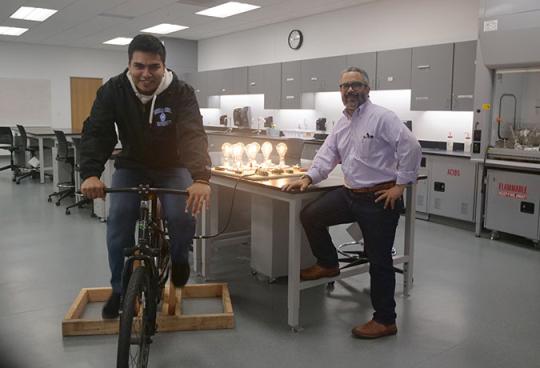Geography, Environment, and Planning (GEP) Department Shines Bright Making the Invisible Visible
"If you look at the mission of Sonoma State University, we are here to serve our basin. We are meant to push the boundaries of knowledge and train students for a lifetime of intellectual work," said Dr. Daniel Soto, Department Chair and Associate Professor of Geography, Environment, and Planning (GEP). "I take that second one seriously."
Customizing his teaching to SSU's strengths and opportunities, Soto said he works with students "to make the invisible visible." His goal is to get more students into STEM and to demystify quantitative concepts for students who have yet to be engaged or feel secluded from the field.
"I want to serve students from a wide variety of backgrounds," he said.
Soto makes complex concepts approachable with gadgets, apparatuses, and demonstrations like electric bikes that power a panel of light bulbs.
"We are doing projects with motors and batteries because many students are jazzed about electric vehicles. We can also put a thermometer that computes on a screen so that students can see the equation in real time," he said.
SSU student Abram Huerta Diaz said the GEP department is an underexplored division on campus, and when students take their projects to demonstrations, people are impressed and excited.
"Dr. Soto makes these complicated concepts more accessible and simplifies them. We use energy daily, and he helps us understand how things work, which is super helpful," Huerta Diaz said.
Like many engineering students in the 1990s and beyond, Soto's physics classes at Stanford were taught by someone in the front of the room writing equations on the board for an hour.
"You copied down the equations in your notebook, and you went home, maybe alone, maybe you had a study group, and you tried to figure out how to do the problems you were assigned," he said.
Although times have changed, it is not students learning differently, he said, teaching is different.
"I want my students to spend time in class, talking with each other and understanding how the equations work with the demonstrations, and walk away with a clear idea of where the X and Y axis are."
Claudia Muralles, SSU GEP student, said, "Dr. Soto ensures that every student feels supported, consistently striving to bring out the best in them."
She added, "Through his teaching methods and projects, Dr. Soto helps each student develop their critical thinking skills and, most importantly, he helps them recognize their intellectual potential."
Working with a Bay Area nonprofit, The Environmental Collective for Environmental Justice (ECEJ), and Partners for Equity Research (P4ER), Soto and a team of student researchers use accurate-time air-quality maps in the Roseland community to collect air pollution data.
Since fall 2022, Muralles has worked on the project and said it empowers residents to understand their environmental challenges and take proactive steps to improve their community and livelihoods.
"This collaborative approach is crucial because it enables community members to make informed decisions regarding the project's direction, drawing from both the data and our collective knowledge and expertise," she said.
The added drive for Soto is energy transition, a sustainable change toward renewable energy systems for a healthy climate and equitable communities. He sees his role as putting SSU students into local industries with a perspective that can put society on the correct course.
"If our students have both technical experience from the hands-on projects and a sense of how things impact communities, then that is a powerful combination to ensure that Sonoma County and Northern California are moving in the right direction," Soto said.
- Krista Sherer, SSU Strategic Communications



